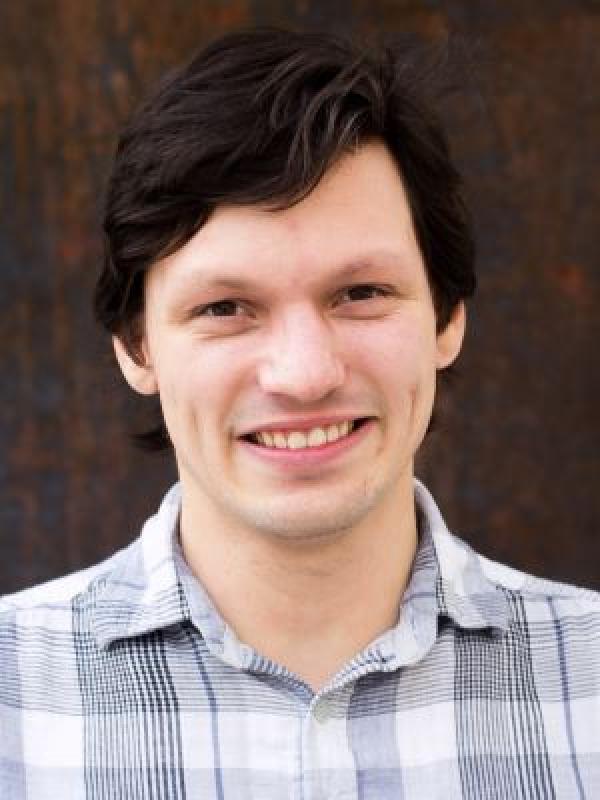
Vladislav Belyy
Assistant Professor
876 Biological Sciences Building
484 W. 12th Avenue
Columbus, OH 43210
Areas of Expertise
- Biochemistry
Biography
Vladislav (Vlad) Belyy got his first taste of experimental research in as an undergraduate student in the laboratory of Dr. Sergei Sukharev at the University of Maryland. There, he studied inactivation and attenuation mechanisms of bacterial mechanosensitive channels and developed the deep fascination with single-molecule studies that persisted throughout his scientific career. After receiving his B.S. from the University of Maryland, Vlad moved across the country to get a Ph.D. in Biophysics from UC Berkeley. There, he joined the lab of Dr. Ahmet Yildiz and began working on the microtubule-associated molecular motor dynein, eventually discovering how dynein’s two “legs” work together to pull against the piconewton-scale forces that dynein encounters in the cell. As a Damon Runyon post-doctoral fellow in Dr. Peter Walter’s lab at UCSF, Vlad switched topics once more to reveal exciting new aspects of endoplasmic reticulum stress sensor activation. Vlad is beginning his independent research career as an Assistant Professor at the Ohio State University in August 2022.
Research Overview
Our lab focuses on a fundamental question: how do cells relay information across membranes? A large fraction of all proteins synthesized by a typical cell serve this very purpose. Thankfully, not every protein evolved a completely unique mechanism of action. Instead, a few general strategies for sending a signal to the other side of a membrane have emerged repeatedly in completely unrelated groups of proteins. One such strategy is oligomerization. A signal on one side, such as the binding of a ligand, can drive a transmembrane protein into a larger cluster, initiating a conformational change or a signaling cascade on the other side of the lipid bilayer. Building a strong functional understanding of oligomeric changes holds the key to unraveling many mysteries in cell signaling.
As it turns out, the experimental study of oligomerization is tricky business. Over- or under-expression of the protein of interest can push the equilibrium far away from biologically relevant levels. Furthermore, it is difficult to experimentally perturb the oligomeric state of a protein without significantly impacting it in other ways. Using endoplasmic reticulum stress sensors as a starting point, we are developing precise and quantitative approaches for both perturbing and measuring oligomerization of signaling proteins in their native environment. Our favorite approaches include single-molecule imaging, protein engineering, genome editing, in vitro biochemistry, and quantitative microscopy. We hope that our work will simultaneously reveal new aspects of stress sensing by the cell and provide a powerful toolbox for the study of signaling proteins in other areas of cell biology.
Recent Publications
The full and up-to-date list of publications can be found in Google Scholar.
A select few are shown below:
Belyy V, Zuazo-Gaztelu I, Alamban A, Ashkenazi A, Walter P. Endoplasmic reticulum stress activates human IRE1α through reversible assembly of inactive dimers into small oligomers. bioRxiv. 2021. doi:https://doi.org/10.1101/2021.09.29.462487
Belyy V, Tran N, Walter P. Quantitative microscopy reveals dynamics and fate of clustered IRE1α. Proc Natl Acad Sci. 2020;117(3):1533-1542.
Belyy V, Shih S-M, Bandaria J, Huang Y, Lawrence RE, Zoncu R, and Yildiz A. PhotoGate microscopy to track single molecules in crowded environments. Nat Commun. 2017;8:13978.
Belyy V, Schlager MA, Foster H, Reimer AE, Carter AP, Yildiz A. The mammalian dynein–dynactin complex is a strong opponent to kinesin in a tug-of-war competition. Nat Cell Biol. 2016;18(9):1018-1024.
Belyy V, Hendel NL, Chien A, Yildiz A. Cytoplasmic dynein transports cargos via load-sharing between the heads. Nat Commun. 2014;5:5544.
Belyy V, Kamaraju K, Akitake B, Anishkin A, Sukharev S. Adaptive behavior of bacterial mechanosensitive channels is coupled to membrane mechanics. J Gen Physiol. 2010;135(6):641-652.
Belyy V, Anishkin A, Kamaraju K, Liu N, Sukharev S. The tension-transmitting “clutch” in the mechanosensitive channel MscS. Nat Struct Mol Biol. 2010;17(4):451-458.
